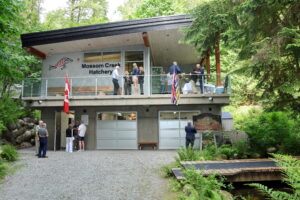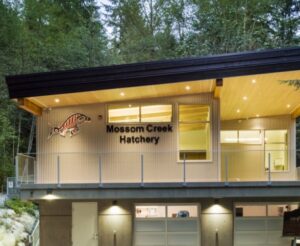 It’s all in the details. Walking around Mossom Creek, most of us notice the trees. (They are hard to miss!) The next time you visit the Hatchery, take a moment to stroll around the area and look closely at the smaller plants.
It’s all in the details. Walking around Mossom Creek, most of us notice the trees. (They are hard to miss!) The next time you visit the Hatchery, take a moment to stroll around the area and look closely at the smaller plants.
- How many berry producing plants can you find, such as salmonberry, elderberry, or salal?
- Can you spot the small flowering plants: boykinia, yellow violets, piggyback plants, tiarella?
- How about the numerous varieties of ferns: maiden, sword, deer, spiny wood, or lady fern?
- Do you know the difference between these relatives: an oval leaved blueberry, a red huckleberry, and an evergreen huckleberry?
- Can you spot the shy trillium?
Once the new Mossom Creek facility was fully operational, it was time to focus on the natural surroundings. The cleared land around the new pond and the new building needed to be restored. Volunteer Ann Patterson stepped up to the challenge and it was a multidimensional  one.
one.
The first goal was to mirror the surrounding natural environment, using only plants that are found in the local habitat. This was not as simple as it appears. While the new gardens are relatively small in area, they are actually quite varied in light and moisture characteristics. For instance the area around the pond is surprisingly dry. The slopes along the side of the building receive very different amounts of sunlight as compared to the areas in front of the building. Thus plant selection and placement required a lot of research, observation, and planning.
A second goal was to support the hatchery’s educational programs. In designing the landscape, Ann focused on including plants that illustrate variety (berries, flowers, textures) and similarities (plants that are related, but differentiated.) Ann carefully planned the landscape to support teaching. As students learn to identify plants and characteristics from the gardens around the facility, they can then test that knowledge in the ‘field’.
Ann definitely enjoyed the challenge: researching and exploring the local habitat, drafting plans and consulting with other BIMES members, and finally acquiring the plants and constructing the landscape—with a lot of help from other volunteers.

Special acknowledgement and thanks to the City of Port Moody for their invaluable assistance in acquiring native plant species, to Ann Patterson for planning and implementing the new landscape, and to the many Sunday work parties and volunteers who dug, planted, and completed the project.
Come visit, observe, and breathe in Mossom Creek’s beautiful natural ‘garden’.


